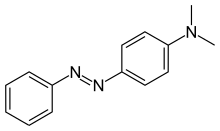Methyl yellow
Methyl yellow, or C.I. 11020, is an organic compound with the formula C6H5N2C6H4N(CH3)2. It is an azo dye derived from dimethylaniline. It is a yellow solid. According to X-ray crystallography, the C14N3 core of the molecule is planar.[3]
 | |
| Names | |
|---|---|
| Preferred IUPAC name
N,N-Dimethyl-4-(phenyldiazenyl)aniline | |
| Other names
4-Dimethylaminoazobenzene p-Dimethylaminoazobenzene DAB N,N-Dimethyl-4-phenylazoaniline N,N-Dimethyl-4-aminoazobenzene Butter Yellow Solvent Yellow 2 C.I. 11020 | |
| Identifiers | |
3D model (JSmol) |
|
| ChEMBL | |
| ChemSpider | |
| ECHA InfoCard | 100.000.414 |
| EC Number |
|
PubChem CID |
|
| RTECS number |
|
| UNII | |
CompTox Dashboard (EPA) |
|
| |
| |
| Properties | |
| C14H15N3 | |
| Molar mass | 225.295 g·mol−1 |
| Appearance | Yellow crystals |
| Melting point | 111–116 °C (232–241 °F; 384–389 K) decomposes[1] |
| 13.6 mg/l | |
| log P | 4.58 |
| Hazards | |
| Occupational safety and health (OHS/OSH): | |
Main hazards |
Carcinogen[2] |
| GHS labelling: | |
  [1] [1] | |
| Danger | |
| H301, H351[1] | |
| P281, P301+P310[1] | |
| NFPA 704 (fire diamond) | |
| NIOSH (US health exposure limits): | |
PEL (Permissible) |
OSHA-regulated carcinogen[2] |
REL (Recommended) |
Ca[2] |
IDLH (Immediate danger) |
Ca [N.D.][2] |
Except where otherwise noted, data are given for materials in their standard state (at 25 °C [77 °F], 100 kPa).
Infobox references | |
It is used as a dye for plastics and may be used as a pH indicator.
| Methyl yellow (pH indicator) | ||
| below pH 2.9 | above pH 4.0 | |
| 2.9 | ⇌ | 4.0 |
In aqueous solution at low pH, methyl yellow appears red. Between pH 2.9 and 4.0, methyl yellow undergoes a transition, to become yellow above pH 4.0.
Safety
It is a possible carcinogen.[2] As "butter yellow", the agent had been used as a food additive in butter and margarine before its toxicity was recognized.[4]
History
Butter yellow was synthesized by Peter Griess in the 1860s at the Royal College of Chemistry in London.[5] The dye was used to dye butter in Germany[5][6] and other parts of the world during the latter half of the 19th century and the beginning of the 20th before being phased out in the 1930s and 40s. It was in the 1930s that research led by Riojun Kinosita showed the link between several azo dyes and cancer, linking butter yellow to liver cancer in rats after two to three months exposure.[7] In 1939, the International Congress for Cancer Research issued a recommendation for the banning of cancer-causing food dyes (including butter yellow) from food production.[5][6]
In 2014, dried tofu products (a.k.a. dougan 豆乾) from Taiwan were found to have been adulterated with methyl yellow, used as a coloring agent.[8]
References
- Dimethyl yellow
- NIOSH Pocket Guide to Chemical Hazards. "#0220". National Institute for Occupational Safety and Health (NIOSH).
- Whitaker A (1992). "Crystal and molecular structure of C.I. Solvent Yellow 2, 1-Phenylazo-4 (N,N-dimethylamine)-phenyl". Journal of Crystallographic and Spectroscopic Research. 22 (2): 151–155. doi:10.1007/BF01186250. S2CID 93052691.
- Opie EL (September 1944). "The Pathogenesis of Tumors of the Liver Produced by Butter Yellow". The Journal of Experimental Medicine. 80 (3): 231–46. doi:10.1084/jem.80.3.231. PMC 2135460. PMID 19871411.
- Ortiz-Gómez T, Santesmases MJ (2016-04-22). Gendered Drugs and Medicine: Historical and Socio-Cultural Perspectives. Routledge. ISBN 978-1-317-12981-3.
- Robert P (1999). The Nazi War on Cancer. Princeton, N.J: Princeton University Press. pp. 165-170. ISBN 978-0-691-00196-8.
- Kinosita R (January 1940). "Studies on the Cancerogenic Azo and Related Compounds". The Yale Journal of Biology and Medicine. 12 (3): 287–300. PMC 2602186. PMID 21433884.
- "Taiwan recalls tainted dried tofu in fresh food scare". Channel NewsAsia. 17 December 2014. Archived from the original on 19 December 2014. Retrieved 13 July 2016.
Further reading
- Chung KT, Fulk GE, Andrews AW (October 1981). "Mutagenicity testing of some commonly used dyes". Applied and Environmental Microbiology. 42 (4): 641–8. doi:10.1128/AEM.42.4.641-648.1981. PMC 244076. PMID 7039509.
